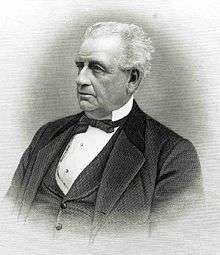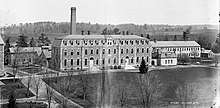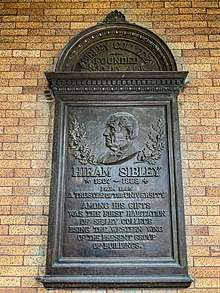Hiram Sibley
Hiram Sibley (February 6, 1807 – July 12, 1888), was an American industrialist, entrepreneur, and philanthropist who was a pioneer of the telegraph in the United States.
Hiram Sibley | |
|---|---|
 | |
| Born | Hiram W. Sibley February 6, 1807 |
| Died | July 12, 1888 (aged 81) |
| Nationality | American |
| Known for | Co-founder and President of Western Union |
| Children | Zilpha Louise Sibley Giles Benjamin Sibley Hiram Watson Sibley Emily Sibley Watson |
Early life
Sibley was born in North Adams, Massachusetts on February 6, 1807, and later resided in Rochester, New York.[1] He was the second son of Benjamin Sibley (1768–1829) and Zilpha (née Davis) Sibley (1771–1824).[2]
Career
Too poor to receive more than a country education, Sibley started training as a shoemaker’s apprentice, but, unhappy with the career, went to Lima, New York at age 17 to work in a cotton factory. The following year he became a wool carder in a shop where future president Millard Fillmore then worked.[3] At age 21 he started a machine shop in Sibleyville, New York that was eventually successful enough for him to sell and afford to move to Rochester, where he was elected Sheriff of Monroe County from 1844 to 1846.[3]
He became interested in the work of Samuel Morse involving the telegraph. In 1851, Sibley and others organized the New York and Mississippi Valley Printing Telegraph Company in Rochester. Sibley later served as first president of Western Union Telegraph Company.[3]
In 1861, Jeptha Wade, founder of Western Union, joined forces with Benjamin Franklin Ficklin and Hiram Sibley to form the Pacific Telegraph Company. With it, the final link between the eastern and western coasts of the United States was made by telegraph. In conjunction with Perry Collins, Sibley later hoped to build a telegraph line from Alaska to Russia through the Bering Strait, the so-called Russian American Telegraph. However, this dream collapsed with the establishment of a cross-Atlantic line to Europe.[3]
Personal life
Sibley was married to Elizabeth Maria Tinker (1815–1903), the daughter of Giles Tinker of Connecticut.[4] Together, they were the parents of:[3]
- Zilpha Louise Sibley (1833–1868)
- Giles Benjamin Sibley (1841–1843), who died in infancy.
- Hiram Watson Sibley (1845–1932), president of Security Trust Company of Rochester.
- Emily Sibley (1855–1945), a founder of the Memorial Art Gallery of the University of Rochester.[5]
After a five-day illness, Sibley died on July 12, 1888 and was interred at Mount Hope Cemetery in Rochester.[3] At his death, his wealth was estimated between $8,000,000 and $10,000,000.[3]
Legacy


In 1874 Sibley funded a library for the University of Rochester.[6] Completed in 1877, it was the second building of the Prince Street campus, and later became part of the Eastman School of Music.[7] The original Sibley Library building was sold in 1956 and torn down in 1968.[8]
In 1876 Sibley founded and endowed the Sibley College of Mechanical Engineering and Mechanic Arts, as well as the building which housed it, Sibley Hall, at Cornell University in Ithaca, New York.[6] The program is now known as the Sibley School of Mechanical and Aerospace Engineering, and is located in parts of Upson, Grumman and Rhodes Halls. Sibley Hall is now a part of the Cornell University College of Architecture, Art, and Planning.
Sibley's home near Rochester, the Hiram Sibley Homestead, was listed on the National Register of Historic Places in 1985. His Rochester home is included in the East Avenue Historic District.[9]
The Hiram Sibley Building was built in 1925 at the corner of East Avenue and Alexander Street in Rochester, New York. It was named in his honor by his son Hiram Watson Sibley, and designed by Shepley, Bulfinch and Abbott of Boston.[10]
References
- Hills, Frederick Simon (1910). New York State Men : Biographic Studies and Character Portraits. Argus Company. p. 196. Retrieved 5 August 2019.
- Scientific American: Supplement. Munn and Company. 1886. p. 8455. Retrieved 5 August 2019.
- "DEATH AT A RIPE OLD AGE | Hiram Sibley is Gathered To His Fathers. The Millionaire Dies After A Brief Struggle--His Life The Story of a Self-Made Man" (PDF). The New York Times. July 13, 1888. Retrieved 5 August 2019.
- The Biographical Record of the City of Rochester and Monroe County, New York. New York: The S.J. Clarke Publishing Company. 1902. p. 11. Retrieved 5 August 2019.
- "Mrs. James S. Watson, Art Patron in Rochester". New York Herald Tribune. 1945-02-09.
- "Hiram W. Sibley House, Rochester New York". Historic Structures. Retrieved 9 February 2020.
- Finn, Kristina. "Prince Street Campus". Retrofitting Rochester. Democrat and Chronicle. Retrieved 9 February 2020.
- "Buildings of the Prince Street Campus". Buildings of the Prince Street Campus. Retrieved 9 February 2020.
Sibley Library, opened 1876, donated by Hiram Sibley ... was sold in 1956 and torn down in 1968.
- "National Register Information System". National Register of Historic Places. National Park Service. March 13, 2009.
- Finn, Michelle. "Hiram Sibley Building". Democrat and Chronicle. Retrieved 9 February 2020.